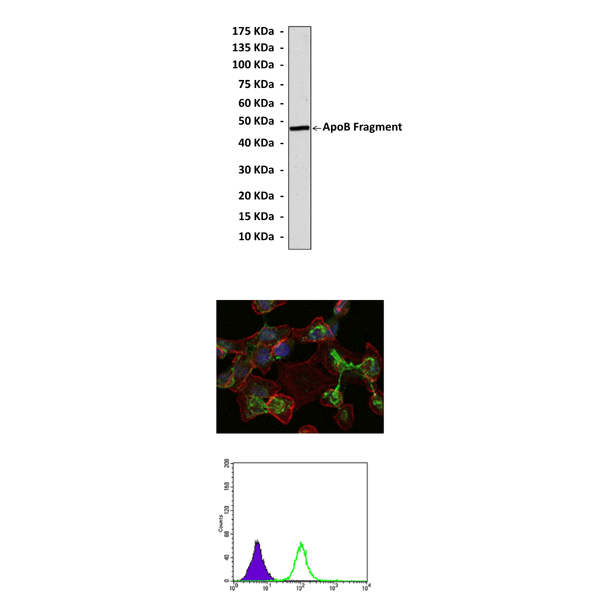Anti-ApoB: Mouse Apolipoprotein B Antibody |
 |
BACKGROUND Apolipoprotein B (ApoB) is the primary apolipoprotein of low-density lipoproteins (LDL or "bad cholesterol"), which is responsible for carrying cholesterol to tissues. While it is unclear exactly what functional role ApoB plays in LDL, it is the primary apolipoprotein component and is absolutely required for its formation. What is clear is that the ApoB on the LDL particle acts as a ligand for LDL receptors in various cells throughout the body (i.e. less formally, ApoB "unlocks" the doors to cells and thereby delivers cholesterol to them). Through a mechanism that is not fully understood, high levels of ApoB can lead to plaques that cause vascular disease (atherosclerosis), leading to heart disease. There is considerable evidence that levels of ApoB are a better indicator of heart disease risk than total cholesterol or LDL. However, primarily for historic reasons, cholesterol, and more specifically, LDL-cholesterol, remains the primary lipid test for the risk factor of atherosclerosis.1
ApoB occurs in the plasma in 2 main isoforms, ApoB48 and ApoB100. The first is synthesized exclusively by the small intestine, the second by the liver. Both isoforms are coded by ApoB and by a single mRNA transcript larger than 16 kb. ApoB48 is generated when a stop codon (UAA) at residue 2153 is created by RNA editing. There appears to be a trans-acting tissue-specific splicing gene that determines which isoform is ultimately produced. Alternatively, there is some evidence that a cis-acting element several thousand bp upstream determines which isoform is produced. As a result of the RNA editing, ApoB48 and ApoB100 share a common N-terminal sequence, but ApoB48 lacks ApoB100's C-terminal LDL receptor binding region. In fact, ApoB48 is so called because it constitutes 48% of the sequence for ApoB100. ApoB 48 is a unique protein to chylomicrons from the small intestine. After most of the lipids in the chylomicron have been digested, ApoB48 returns to the liver as part of the chylomicron remnant, where it is endocytosed and degraded.2
ApoB100 is found in lipoproteins originating from the liver (VLDL, IDL, LDL). It is well established that ApoB100 levels are associated with coronary heart disease, and are even a better predictor of it than is LDL level. Hypobetalipoproteinemia is a genetic disorder that can be caused by a mutation in the ApoB gene. Mutations in gene ApoB100 can also cause Familial hypercholesterolemia, a hereditary (autosomal dominant) form of metabolic disorder Hypercholesterolemia.3
ApoB occurs in the plasma in 2 main isoforms, ApoB48 and ApoB100. The first is synthesized exclusively by the small intestine, the second by the liver. Both isoforms are coded by ApoB and by a single mRNA transcript larger than 16 kb. ApoB48 is generated when a stop codon (UAA) at residue 2153 is created by RNA editing. There appears to be a trans-acting tissue-specific splicing gene that determines which isoform is ultimately produced. Alternatively, there is some evidence that a cis-acting element several thousand bp upstream determines which isoform is produced. As a result of the RNA editing, ApoB48 and ApoB100 share a common N-terminal sequence, but ApoB48 lacks ApoB100's C-terminal LDL receptor binding region. In fact, ApoB48 is so called because it constitutes 48% of the sequence for ApoB100. ApoB 48 is a unique protein to chylomicrons from the small intestine. After most of the lipids in the chylomicron have been digested, ApoB48 returns to the liver as part of the chylomicron remnant, where it is endocytosed and degraded.2
ApoB100 is found in lipoproteins originating from the liver (VLDL, IDL, LDL). It is well established that ApoB100 levels are associated with coronary heart disease, and are even a better predictor of it than is LDL level. Hypobetalipoproteinemia is a genetic disorder that can be caused by a mutation in the ApoB gene. Mutations in gene ApoB100 can also cause Familial hypercholesterolemia, a hereditary (autosomal dominant) form of metabolic disorder Hypercholesterolemia.3
REFERENCES
1. McQueen, M.J. et al: Lancet 372:224-33, 2008
2. Pontrelli, L. et al: Biochem. 43:6734-44, 2004
3. Benn, M. et al: Arterioscler. Thromb. Vasc. Biol. 27:661-70, 2007
2. Pontrelli, L. et al: Biochem. 43:6734-44, 2004
3. Benn, M. et al: Arterioscler. Thromb. Vasc. Biol. 27:661-70, 2007
Products are for research use only. They are not intended for human, animal, or diagnostic applications.
Параметры
Cat.No.: | CP10393 |
Antigen: | Raised against recombinant human ApoB fragments expressed in E. coli. |
Isotype: | Mouse IgG1 |
Species & predicted species cross- reactivity ( ): | Human |
Applications & Suggested starting dilutions:* | WB 1:1000 IP n/d IHC 1:50 - 1:200 FACS 1:50 - 1:200 ICC 1:50 - 1:200 |
Predicted Molecular Weight of protein: | 51/56 kDa |
Specificity/Sensitivity: | Detects ApoB proteins in various cell lysate. |
Storage: | Store at -20°C, 4°C for frequent use. Avoid repeated freeze-thaw cycles. |
*Optimal working dilutions must be determined by end user.
Документы
Информация представлена исключительно в ознакомительных целях и ни при каких условиях не является публичной офертой








